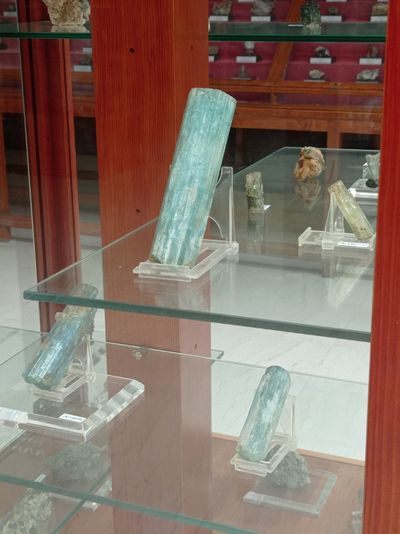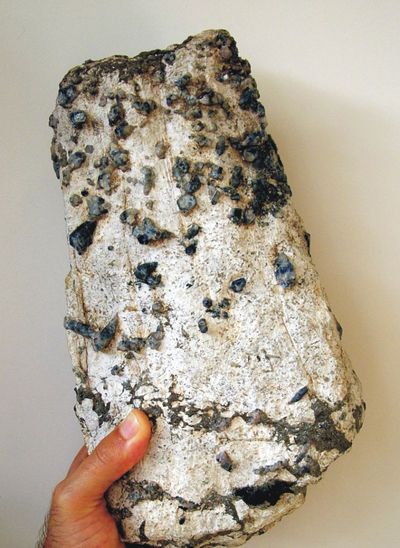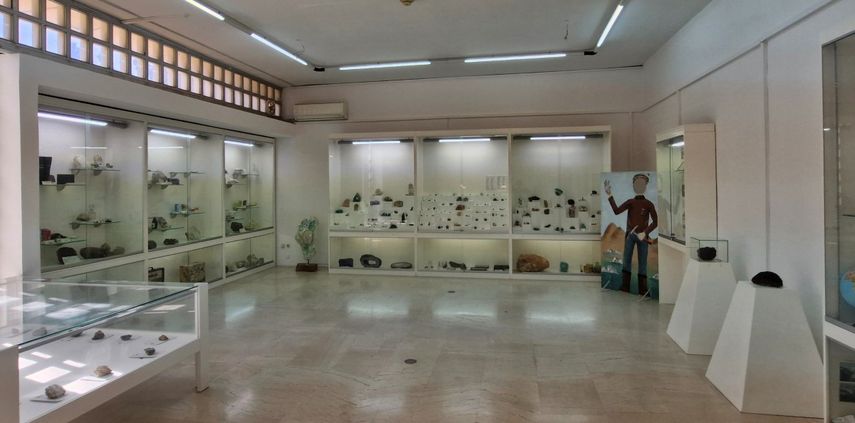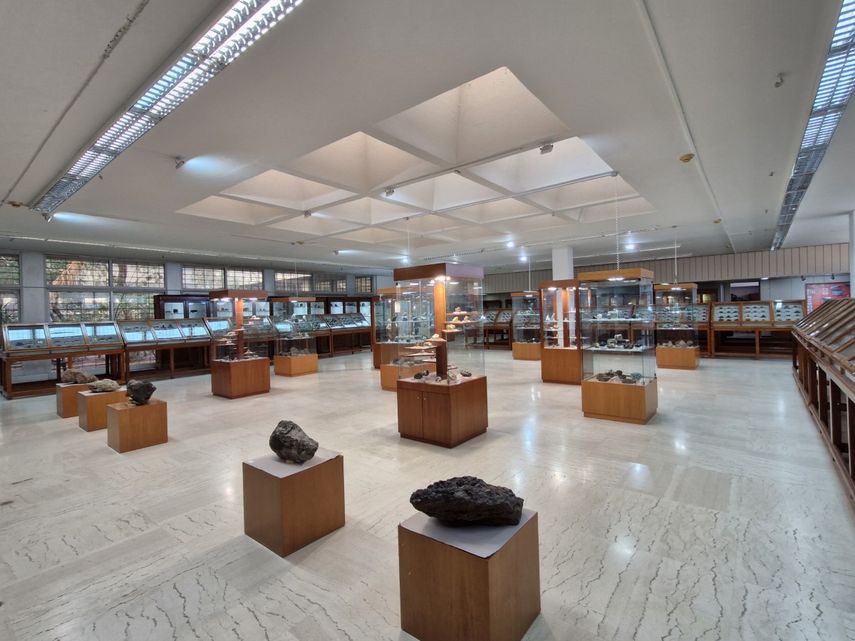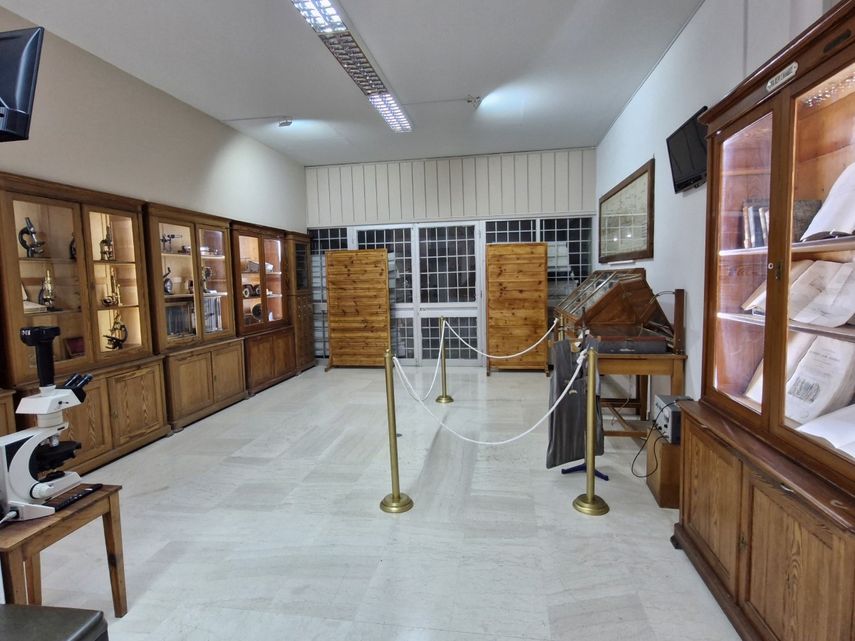MUSEUM OF MINERALOGY AND PETROLOGY
The Museum of Mineralogy and Petrology of the National and Kapodistrian University of Athens, Greece, is the most important Museum of its kind in Greece, with a long research and educational tradition. The Museum has the oldest and most complete mineralogical-petrographic collection in Greece, but also a collection of international importance, since it exhibits world-class mineral specimens. The Museum belongs to the Faculty of Geology & Geoenvironment located in the University Campus, Zografou, Greece. It includes four halls and laboratory, office and storage areas with a total surface area of approximately 1200 m2.
Ι. HISTORICAL INFORMATION
The collections of the Museum of Mineralogy and Petrology were created within the framework of the Physiographic Society, founded in 1835. To date, it has welcomed thousands of visitors from primary and secondary education, undergraduate and postgraduate students, mineral collectors, Greek and foreign researchers, forming an important link between science and society.
The majority of the Museum's exhibits were acquired mainly from donations of specimens from Greece and abroad. The first important collections were acquired by the Museum in 1858 and 1860 following donations from Kämmerer and Haritov, minister and consul in St. Petersburg, respectively, which included specimens of minerals and precious stones from Tsarist Russia. Important donations of minerals from Greece were those of Otto and Amalia in 1863, A. Lindermayer in 1868 and F. Negris in 1928.
The Museum of Mineralogy-Petrology currently has at least 45,000 samples of minerals, rocks and ores, of which about 3,000 mineral samples and 650 rock samples are on display. The museum has the best systematic collection of minerals in Greece with more than 700 species of minerals classified in all known classification categories. The Museum's collections include a rich historical archive with original donation documents and historical geological maps.
Beryl crystals (variety aquamarine) from Adun-Cholon, Nerchinsky Region, Russia
Smoky quartz crystal in the form of a scepter from Minas Gerais, Brazil
The importance of the Museum's collection is not only due to the presentation of particularly aesthetic mineral specimens, but also to the abundance and quality of specimens from "historical" sites of the former Austro-Hungarian Monarchy, Tsarist Russia, but also from other well-known sites abroad, such as Cornwall, Vesuvius, the Alps, and mainly from sites that are currently known only from literature. The museum's unique exhibits cover the widest range of minerals and gemstones extracted in the 18th and 19th centuries, mainly from the Urals and Siberia, many of which are 'type-locality' minerals, i.e. minerals that were first identified worldwide at these sites. Outstanding are specimens of platinum, malachite and gemstones, all of which adorn only the largest mineral collections in the world, such as: topazes, alexandrites, emeralds, sapphires, aquamarines and a plethora of other exhibits of "historic" specimens of high aesthetic and historical value, some of which are among the best of their kind. A scepter-shaped specimen of smoky quartz mined in Minas Gerais, Brazil, possibly the largest quartz scepter in the world, is a unique exhibit in the Museum.
Sapphires in plumasite from Naxos island, Greec
Smithsonite. A specimen unique in the world from the Jean Baptiste mine in Κamariza, Lavrion, Greece
Specimens from "classical" sites in Greece, such as Lavrion, Serifos island, Naxos island and Chalkidiki, are prominent in the Museum. The first hall of the Museum is dedicated to Lavrion, a region that has played an important role in the "Roos of History" and in the course of Western civilization, but which is also a minerals "paradise". The collections of Lavrion present unique exhibits dating from the end of the 19th century to the beginning of the 20th century, as well as exceptional specimens of rare minerals from Lavrion, where more than 750 different types of minerals have been identified, representing 12% of the world's minerals.
ΙΙ. DESCRIPTION OF THE MUSEUM
The exhibition of the Museum's collections takes place in three halls:
The first hall is adorned with nine modern crystal showcases, internally illuminated, dedicated to minerals from the mines of Lavrion. Two separate showcases display the type locality minerals of Lavrion. Three showcases are dedicated to the ancient mining-ore metallurgy of Lavrion. Finally, informative audiovisual material presents microscope photographs of the 750 different minerals of Lavreotiki.
The second hall of the Museum contains educational collections and is mainly of a didactic nature. In three built-in display cases, samples and explanatory texts are presented for the understanding of the concept of minerals, rocks, and ores. Specimens are also displayed to explain the physical properties of minerals such as transparency, hardness, and color. Impressive specimens on rotating pedestals on twenty-eight specially designed pedestals indicate the color variety of minerals. Sixteen of the main industrial minerals are presented in the next three built-in displays. In a separate showcase, metallic and non metallic minerals from Greece that are carriers of energy-critical metals are presented. The samples are accompanied by informative texts, as well as indicative products made from them. At the back of the hall, three showcases with collections of gemstones from abroad and Greece are presented. One contains sculptures made from minerals and rocks, the second contains raw and faceted gemstones, and the third contains gemstones from Greece. In the special showcase dedicated to meteorites, a sample of iron meteorite from Argentina is on display. A special showcase is dedicated to the chemical elements present in the human body with corresponding examples of minerals containing them. A darkroom has been set up on the east side of the room to demonstrate the luminescence of minerals. This is one of the largest collections in Europe, demonstrating the fluorescence and phosphorescence of minerals using ultraviolet light tubes of various wavelengths.
Industrial minerals, gemstones from Greece, meteorites, and minerals of critical metals from the second hall of the museum which includes educational - teaching collections
View of a display case with fluorescent minerals in ultraviolet light from the second hall of the Museum
In the third hall the visitor encounters the heavy, wooden showcases of the 19th century. The walls are covered by tall upright display cases, while inside the room there are low sloping cases where the systematic collection is housed. The decoration of the second hall is in complete harmony with the museum's exhibits, most of which date back to the 19th century. This hall includes:
(a) the systematic collection of minerals
(b) the collection of minerals from important sites abroad
(c) collections of Greek minerals (outside Lavrio)
(d) petrographic collections from Greece and abroad
(e) collections of ores minerals and coals from Greece
(f) Collections of wooden and glass crystal models
(g) Historical corner of the Museum
(a) The systematic mineral collection extends throughout the third hall. It enables the visitor to get acquainted with the variety of minerals, as 1,800 specimens representative of more than 700 types of minerals, classified on a modern basis, are on display. The visitor should spend several hours to get to know the wealth of minerals available in the museum, many of which are type locality species.
Panoramic view of the third hall of the Museum with minerals from abroad, Greece and systematic collection
(b) At the entrance to the third hall there are two impressive quartz specimens (varieties rocky crystal and amethyst) in special display cases, as well as a 116 cm high amethyst geode. In the centre of the third hall, the most important and rare mineral specimens from abroad have been selected and are displayed in 9 modern showcases. These are specimens of minerals of high aesthetic value, some of which are among the finest of each species. Three of the showcases contain world-class mineral and gemstone specimens from Tsarist Russia. These specimens cover the widest range of minerals mined two centuries ago, mainly from the Ural region and Siberia. The next three showcases display European historical specimens from renowned mines, such as Freiberg in Germany, Banská Štiavnica in Slovakia, Canvic in Romania, and many others. The last 3 showcases feature samples from America, Asia, Africa, and Australia.
(c) In the northern part of the third hall, collections of minerals from Greece are exhibited in heavy, 19th century wooden cases. The special thematic collections concern minerals mainly from well-known mining centres in Greece such as Chalkidiki, Serifos, Naxos and other areas of particular interest. These thematic collections are complemented by minerals from the rest of Greece, such as Paros, Syros, Milos, Western Thrace, Attica and Evia. Informative audiovisual material presents photographs from the field and from mineral samples of Greece.
(d) On the west side of the third hall, collections of Greek rocks are displayed in 19th century wooden cases, and all categories of rocks are presented with representative samples from abroad. In the petrographic collection there is a special tribute to the volcano of Santorini with rich photographic material, accompanied by relevant texts and samples.
(e) the collections of Greek ores and minerals are displayed in 19th century wooden cases in the east wing of the third hall. All types of ores are covered based on modern classifications from major mining centres in Greece. The ore collection is complemented by a display case with samples of active submarine hydrothermal deposits from the Mid-Ocean Ridge of the Atlantic Ocean, as well as informative audiovisual material from corresponding active systems from the Tonga volcanic arc region of the Pacific Ocean.
(f) On the south side of the third hall, wooden and glass crystal models are displayed in wall cases. These are rare pieces of exceptional art. Especially the 19th century glass models, in which the axes of symmetry of the crystal can be seen on the inside.
(g) The historical corner of the museum has a special place at the back of the third hall. There are microscopes, goniometers and other scientific instruments from the 19th century, mineralogy and petrology books from the 18th and 19th centuries, rock samples and a geological cross-section of the Simplon tunnel in the Alps from the 19th century. Informative audiovisual material presents the geological evolution of the Alps, as well as the hunting for minerals in the various Alpine rocks. Using a polarizing transmitted light microscope, visitors can admire the microcosm of rocks and minerals on a TV screen. The display case with radioactive minerals is also on display in the historic corner. Protection from radiation is complete, as the showcase is covered with lead sheets and special lead glasses. The minerals are observed through a mirror, so that the observer does not have to approach the display case. Explanatory texts provide information on the relevant topics.
A historical corner in the third hall of the museum with microscopes and mineralogy books from the 18th-19th century, with specimens from the Simplon tunnel in the Alps, and a showcase of uranium minerals
Finally, the fourth hall is an audiovisual and lecture room.
ΙΙΙ. ACTIVITIES OF THE MUSEUM
The collections of the Museum of Mineralogy and Petrology aim to support the educational work of the Faculty of Geology and Geoenvironment at undergraduate and postgraduate level, enhancing scientific research and the transmission of knowledge both to the university community and to the wider public. To fulfill its objectives, the Museum creates and maintains teaching and research collections from the country and abroad, conducts scientific research, organizes lectures, exhibitions, educational programs and other events that help in the dissemination of knowledge and the promotion and protection of the country's findings. Through the education and training of pupils and students in Mineralogy, Petrology, Geology and the general dissemination of knowledge about Greek nature, it contributes to their awareness of environmental issues. The Museum is visited by thousands of visitors annually. As part of the extroversion of the University Museums, the Museum participates in numerous events, international mineral exhibitions and workshops. Educational programs are held at the Museum of Mineralogy and Petrology, aimed at students, teachers and primary and secondary school teachers. Their aim is to focus their interest on the inseparable relationship between the living world and the mineral world. In the service of education and interdisciplinarity, the Museum makes its collections available for research, study and practical training to undergraduate and postgraduate students not only from the Faculty of Geology and Geoenvironment but also from other Faculties in Universities in Greece and abroad. The results of these collaborations have been presented in theses, scientific publications in journals and conferences.
Museum Scientific Committee:
| Full Name | Title | Telephone | |
| Panagiotis Voudouris | Museum Director, Professor | voudouris[at]geol.uoa[dot]gr | +30 210 727 4129 |
| Athanassios Godelitsas | Professor | agodel[at]uoa[dot]gr | +30 210 727 4689 |
| Marianna Kati | Assist. Professor | kati@geol.uoa.gr | +30 210 727 7442 |
Contact
The Museum of Mineralogy and Petrology is located on the ground floor of the Faculty of Geology and Geoenvironment at the University Campus, 15772, Zografou, Athens.
It is open from Monday to Friday 9.30 - 14.00. It is closed on public holidays, Christmas, Easter and August holidays.
It is accessible to disabled people.
Contact: mineralmuseum@geol.uoa.gr
Telephone: +30 210-7274112, +30 210-7274180
On social media the museum has the following links:
www.facebook.com/MineralogyAndPetrologyMuseum
www.instagram.com/mineralogy_museum

